|
Back
to Illustrated Sites of Greece
Lion
Gate
Grave Circles
King's
Megaron
Cistern
Clytemnestra's Tomb
Treasury of
Atreus
Lion Tomb
|
 |
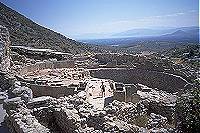 Dr. J's
Illustrated Grave Circles at Mycenae Dr. J's
Illustrated Grave Circles at Mycenae
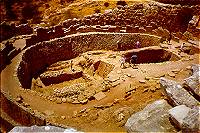 Grave
Circle A lies directly inside and to the right of the Lion Gate entrance. It
contains 6 shaft graves, which contained 19 bodies: 9 men, 8 women, 2
children. Five of these Royal Graves were discovered with their embalmed
bodies and grave goods intact by Schliemann ( the last was discovered by a
Greek archaeologist named Stamatakis) and their finds nearly fill the main
gallery of the National Archaeological Museum in Athens. Note the Cyclopean
Wall behind the circle. The fortification walls were extended in c. 1250 BC
to incorporate Grave Circle A within the confines of the citadel; earlier it
had stood outside. The incorporation of the circle was probably an attempt
by later rulers to appropriate the heroic past as their own. Grave
Circle A lies directly inside and to the right of the Lion Gate entrance. It
contains 6 shaft graves, which contained 19 bodies: 9 men, 8 women, 2
children. Five of these Royal Graves were discovered with their embalmed
bodies and grave goods intact by Schliemann ( the last was discovered by a
Greek archaeologist named Stamatakis) and their finds nearly fill the main
gallery of the National Archaeological Museum in Athens. Note the Cyclopean
Wall behind the circle. The fortification walls were extended in c. 1250 BC
to incorporate Grave Circle A within the confines of the citadel; earlier it
had stood outside. The incorporation of the circle was probably an attempt
by later rulers to appropriate the heroic past as their own. |
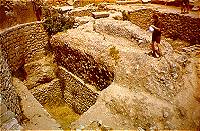 The
shaft graves date to 1580-1500 BC and reveal extensive trading practices and
impressive wealth. Found in these 6 graves were objects representing or at
least inspired by Mycenean, Minoan, Cycladic, Hittite (Anatolian), and
Egyptian cultures. Based on the condition of the finds, scholars suppose
that the bodies were laid in on top of a layer of pebbles and grave goods
were then placed within the grave. Sherds of cups found near the top of the
shafts suggest one final toast to the departed before the graves were filled
in with dirt. The
shaft graves date to 1580-1500 BC and reveal extensive trading practices and
impressive wealth. Found in these 6 graves were objects representing or at
least inspired by Mycenean, Minoan, Cycladic, Hittite (Anatolian), and
Egyptian cultures. Based on the condition of the finds, scholars suppose
that the bodies were laid in on top of a layer of pebbles and grave goods
were then placed within the grave. Sherds of cups found near the top of the
shafts suggest one final toast to the departed before the graves were filled
in with dirt. |
  Grave
Circle A was girded by a double wall, the middle of which seemed to have
been filled with rubble. In the photo on the right, we can see how wooden
beams would have been fitted into recesses to cover the gap, and then
limestone slabs were placed on top. Schliemann originally thought that the
wall would make suitable seating for men of "heroic" stature. Grave
Circle A was girded by a double wall, the middle of which seemed to have
been filled with rubble. In the photo on the right, we can see how wooden
beams would have been fitted into recesses to cover the gap, and then
limestone slabs were placed on top. Schliemann originally thought that the
wall would make suitable seating for men of "heroic" stature. |
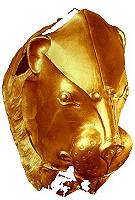 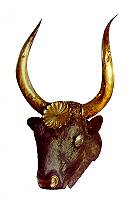 Two
exquisite finds from Grave IV of Grave Circle A dating from the 16th century
BC, on display in the National Archaeological Museum in Athens: on the left,
an embossed sheet gold lion's head rhyton (a ritual vessel used to pour
libations) and on the right, a silver bull's head rhyton with gold horns and
a forehead rosette. Both shapes were inspired by Minoan ritual containers of
stone, but the metal "translations" have been found only on the mainland - a
sign of early Mycenaean wealth. Two
exquisite finds from Grave IV of Grave Circle A dating from the 16th century
BC, on display in the National Archaeological Museum in Athens: on the left,
an embossed sheet gold lion's head rhyton (a ritual vessel used to pour
libations) and on the right, a silver bull's head rhyton with gold horns and
a forehead rosette. Both shapes were inspired by Minoan ritual containers of
stone, but the metal "translations" have been found only on the mainland - a
sign of early Mycenaean wealth. |
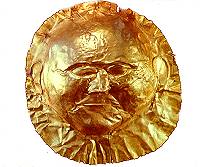 This
gold death mask from Shaft Grave IV of Grave Circle A depicts a beardless
man whose closed eyes lack any detail. Probably made out of gold plate
pounded out over a wooden mold, these are strictly funeral masks. Only a few
individuals wore these, probably all men. The "mask of Agamemnon" (this is
not it) is so named because when the awed Schliemann found it he telegraphed
to the King of Greece: "I have gazed upon the face of Agamemnon." In fact,
Schliemann had stumbled upon royal graves from a period even earlier than
the Homeric Age he sought. This
gold death mask from Shaft Grave IV of Grave Circle A depicts a beardless
man whose closed eyes lack any detail. Probably made out of gold plate
pounded out over a wooden mold, these are strictly funeral masks. Only a few
individuals wore these, probably all men. The "mask of Agamemnon" (this is
not it) is so named because when the awed Schliemann found it he telegraphed
to the King of Greece: "I have gazed upon the face of Agamemnon." In fact,
Schliemann had stumbled upon royal graves from a period even earlier than
the Homeric Age he sought. |
  On
the left, bronze daggers inlaid with exquisitely fashioned gold, silver, and
copper figures set in niello to form hunt scenes. On the right, a
diadem of gold pieces and individual gold medallions possibly intended for
clothing decoration. Many of the foil ornaments are so flimsy that they may
have only been used to decorate costumes for special occasions, such as
funerals. On
the left, bronze daggers inlaid with exquisitely fashioned gold, silver, and
copper figures set in niello to form hunt scenes. On the right, a
diadem of gold pieces and individual gold medallions possibly intended for
clothing decoration. Many of the foil ornaments are so flimsy that they may
have only been used to decorate costumes for special occasions, such as
funerals. |
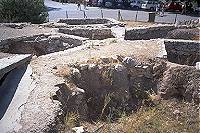 Grave
Circle B lies 130 meters west of the Lion Gate but the walls were never
extended to include it in the fortified area of the citadel. The circle is
28 meters across and contains more cist than shaft graves, all dating to
1625-1520 BC: 16 men, 5 women, 2 children. Forensic evidence proves that
they were a large big-boned people who led active - though brief - lives.
Dating before Grave Circle A, the graves in Circle B reflect a culture not
quite as cosmopolitan and wealthy, but the grave goods found are remarkable
nevertheless: swords, vases and in particular that gorgeous rock crystal
vase cut in the shape of a duck (illustrations pending). Grave
Circle B lies 130 meters west of the Lion Gate but the walls were never
extended to include it in the fortified area of the citadel. The circle is
28 meters across and contains more cist than shaft graves, all dating to
1625-1520 BC: 16 men, 5 women, 2 children. Forensic evidence proves that
they were a large big-boned people who led active - though brief - lives.
Dating before Grave Circle A, the graves in Circle B reflect a culture not
quite as cosmopolitan and wealthy, but the grave goods found are remarkable
nevertheless: swords, vases and in particular that gorgeous rock crystal
vase cut in the shape of a duck (illustrations pending). |
|
